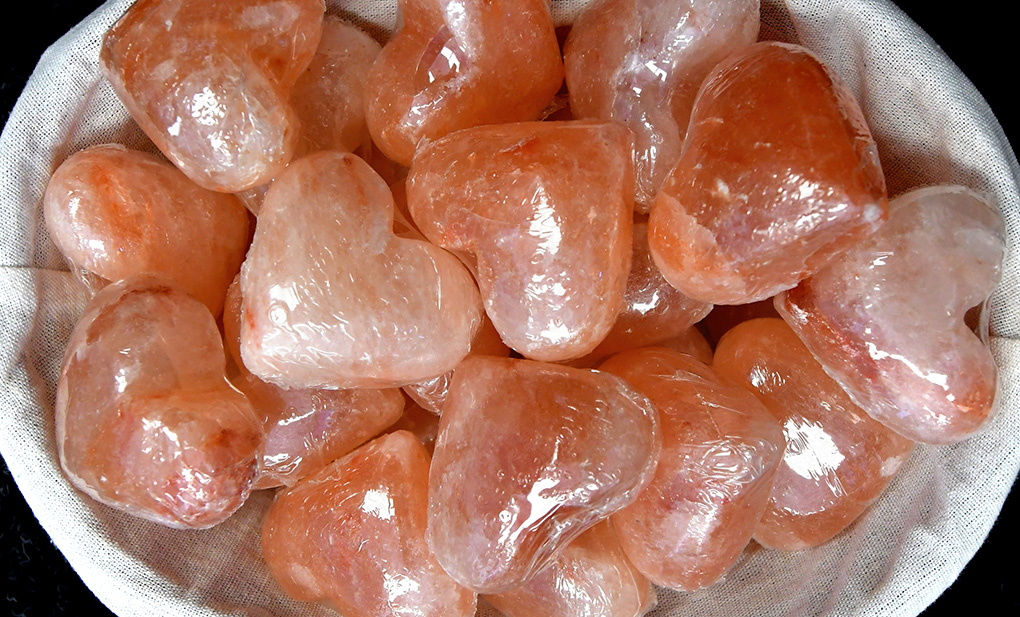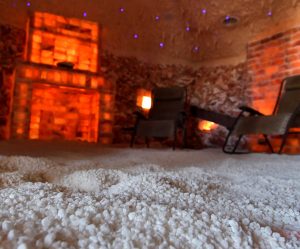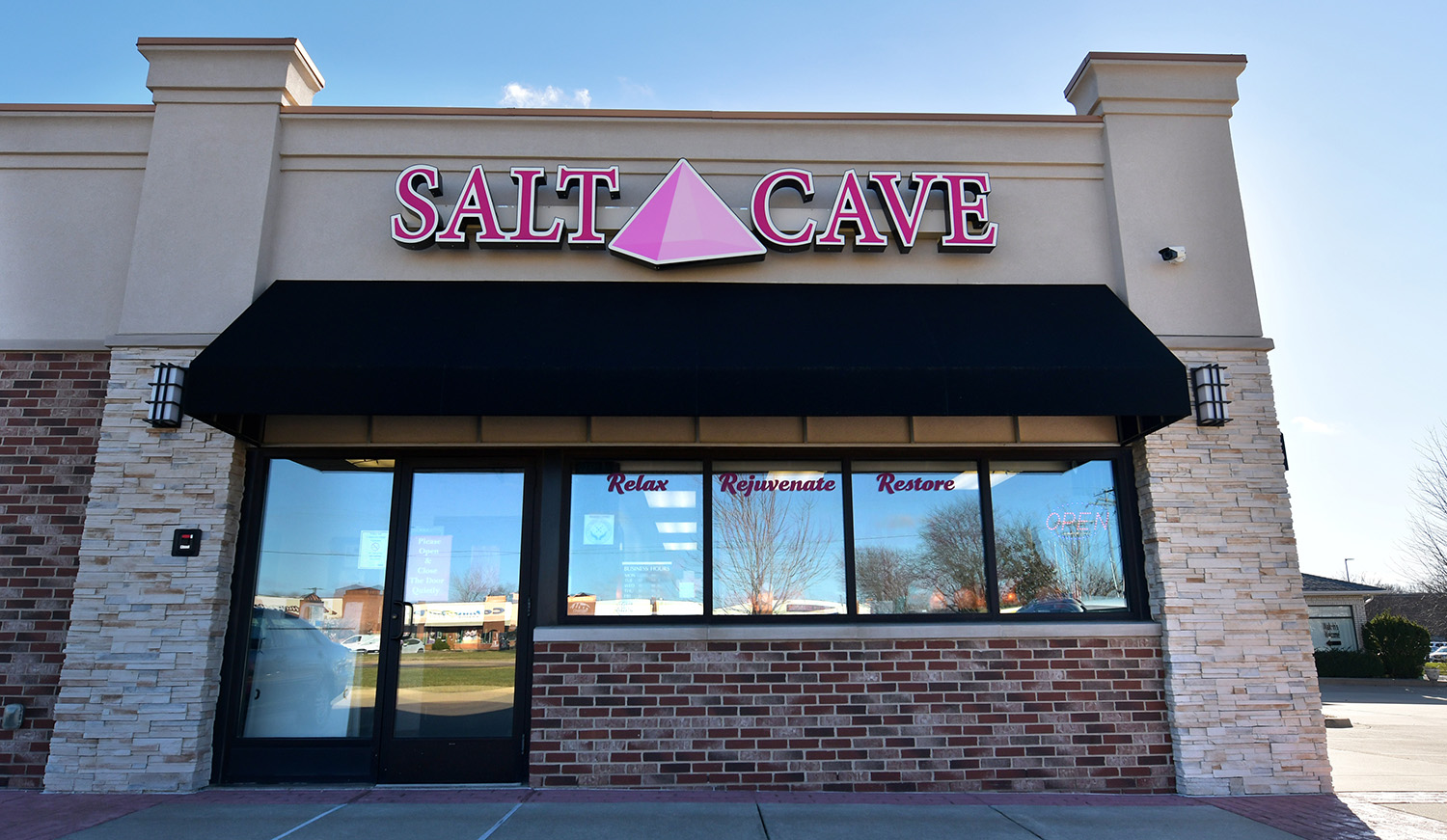Pioneer Parkway in Peoria is not where you might expect to find a calming oasis or a centuries-old healing practice. Yet that’s what visitors discover at Peoria Himalayan Salt Cave.
The lobby area is bright and clean, as professional and welcoming as any modern massage or spa business. But behind a seemingly ordinary door is a world of wonder.

Sock-clad visitors find a rose-hued room with fairy lights embedded in the ceiling and more than 11,000 pounds of Himalayan salt on the walls and floor. The soft crunch of salt pebbles mingles with calming music. Six guests at a time choose a zero-gravity recliner to relax in during their session. Some grab a clean, fluffy blanket to stay warm in the 68-degree, low-humidity environment. Once the door closes, a generator clicks on, quietly pumping micro-sized particles of pharmaceutical-grade pure sodium chloride in over 45 minutes.
The benefits? Quite a few, says owner Nikki Wenzelspratt.
“You breathe it [salt] in, and it works its way into your respiratory system, even down into your lungs. And it cleans, purifies, and reduces swelling in the respiratory tract, not just that day. We keep salt balls in our cave, and customers have told us that just … holding these salt balls in their hands has helped their arthritis. They feel like they have better movement and less pain.”
Wenzelspratt first encountered salt therapy around a decade ago. At the time, she was teaching and would take weekend spa getaways to relax. She stumbled upon a salt cave in Naperville, the first one in Illinois, and decided to try something new.
“When I left there, I just felt so good,” she said. “I struggle with allergies anyway, but at the time didn’t quite know what I’ve come to know since. But when I left, I just felt good overall. My body felt better.”
 Wenzelspratt started going to the salt cave several times a year, sometimes for multiple days. As she neared the end of her 21-year teaching career, she knew she wanted to own her own business. In 2017, she decided to bring a salt cave to Peoria. After months of research, she selected a cave-building company out of Canada, which built a custom cave in about four weeks.
Wenzelspratt started going to the salt cave several times a year, sometimes for multiple days. As she neared the end of her 21-year teaching career, she knew she wanted to own her own business. In 2017, she decided to bring a salt cave to Peoria. After months of research, she selected a cave-building company out of Canada, which built a custom cave in about four weeks.
“We opened in February of 2018. I wasn’t prepared for the response it got. I was hoping that the word would get out, so I posted on Facebook. Things kind of went crazy from there. We had a lot of followers from the very beginning — I think within a year we maybe had 7,000 — so that was really what helped get the ball rolling.”
Scientists started studying salt therapy in the 1800s because salt miners had much better health than other miners. Dr. Feliks Boczkowski opened the Wieliczka Salt Mine in Poland in 1839, offering salt baths that are still the basis of wet salt therapy techniques used today.
Dry salt therapy first began being studied in Germany in 1949. The first medical halotherapy center was established in 1985 in Russia. The techniques pioneered there are now used throughout Europe, Australia and North America.
According to the Salt Therapy Association, an international organization established in 2012, salt caves remove toxins from the respiratory system. This therapy offers potential benefits for people suffering from allergies and common colds to COPD and cystic fibrosis.
“I have sinus infections constantly and it’s really good for that,” said customer Genevieve Ferrel. “It was so calming and relaxing. I loved it. I didn’t want to leave.”
“I first visited Peoria Himalayan Salt Cave four years ago,” said another customer, Megan Sack. “I’ve always had significant pet allergies which introduce asthmatic symptoms. That morning, I was having some minor wheezing and felt the urge to use my inhaler, but I thought I’d see if I noticed any benefits from sitting in the Salt Cave first. …By the end of a 45-minute session, I noticed relief… I was sold.
“In my four years of going to the Peoria Himalayan Salt Cave, I have rarely been sick. I believe the halotherapy supports and boosts my immune system.”
Meanwhile, patients looking for skin benefits can use high salt concentration with consistent administration. Salt normalizes ph, which can help repair and regenerate skin. People with inflammatory conditions, psoriasis and acne can all benefit from halotherapy.
Though recognized as a safe and effective practice for preventive and restorative health care, halotherapy is not for everyone. Those with active infections, fever, lung cancer, open wounds and tuberculosis should not use salt halotherapy. Wenzelspratt suggests consulting a doctor if you have concerns about starting salt therapy.
“Pretty much 99%, if not everyone that leaves the cave feels better in some way,” says Wenzelspratt. “We are around positive or pollutant ions all the time from our devices, TVs and computers. Salt produces negative ions. When you’re in a salt-rich environment like that, those negative ions help counter those positive ions. And it just creates that feeling of well-being, which I think we don’t really realize that we need.”
Salt cave visitors are encouraged to wear comfortable clothing so they can relax. It’s not unheard of for guests to fall asleep during sessions. Some people may experience a dry throat after a session. This is a natural effect of the salt particles breaking up mucus in the body.
While halotherapy can cost up to $60 a session depending on location and length of session, Peoria Himalayan Salt Therapy charges $30. Discounts are offered on Tuesdays. Yoga and sound meditation are scheduled in the cave throughout the year as special events. Those looking for frequent sessions can get memberships starting at $60.
Wenzelspratt encourages people to schedule a session or just drop in to see if salt therapy is right for them.
“It’s very rare that someone will tell us that they don’t necessarily see a benefit,” she said. “To be honest, it has helped me personally, but my favorite part is when customers tell me how much better they feel when they leave.”
For more info about Peoria Himalayan Salt Cave, visit www.peoriasaltcave.com.





